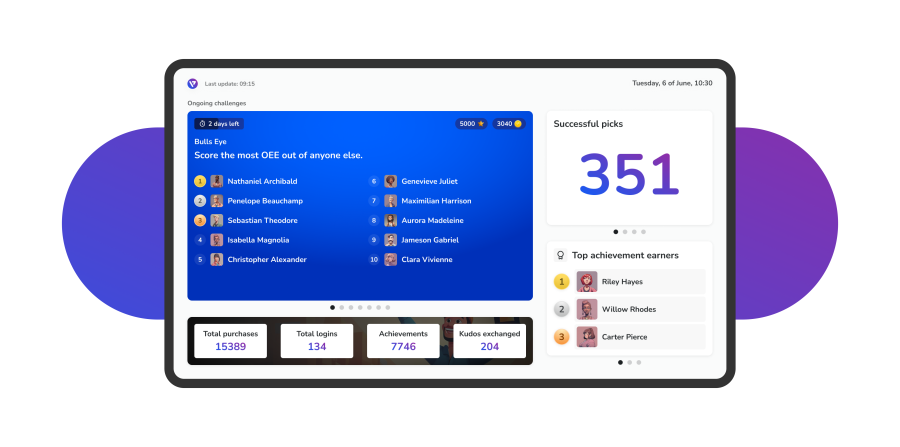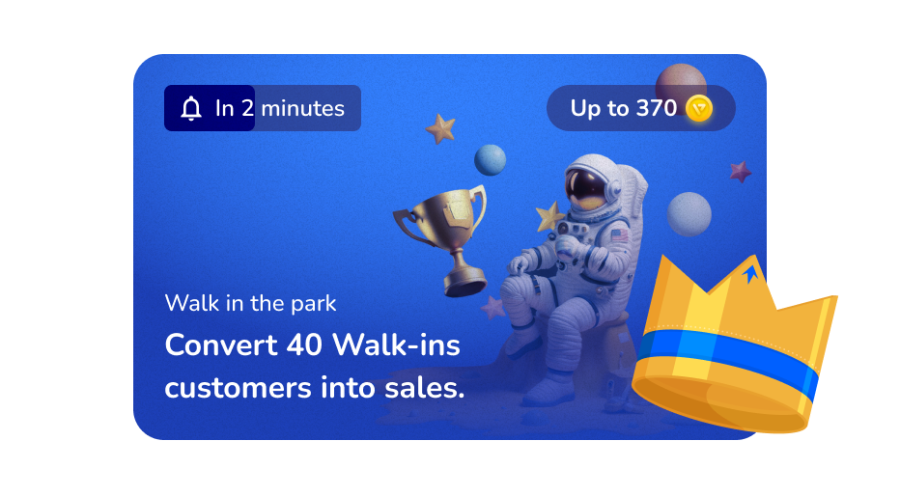Discover how gamification simplifies measuring team performance with real-time feedback and clear metrics.

Back to Blog
We all know motivation fuels performance. But monitoring team productivity isn’t always easy. It often relies on multiple, disconnected tools, making the process complex, fragmented and far from real-time.
If your team is relying solely on quarterly reviews to measure success, you’re probably missing the daily wins (and red flags) that matter most. Gamification doesn’t just boost engagement, it provides managers with valuable insights into what’s working, what’s not and how each team member is performing. It’s a practical, data-rich solution that helps identify areas for improvement and visualize performance through challenges, leaderboards, rewards and real-time data, empowering data-driven decisions every step of the way.
According to a survey by TalentLMS, 89% of employees say gamification makes them feel more productive and 88% say it makes them happier at work. But how can you use gamification to better understand how your team is performing “against” key performance metrics? That’s exactly what we’ll explore today.
When a company decides to integrate a gamified strategy, it means they are embedding game elements such as challenges, point systems, leaderboards and rewards into employees’ daily tasks. This approach brings benefits from both the employee and management perspectives.
On the employee side, gamification taps into both intrinsic and extrinsic motivation:
By stimulating both types of motivation, gamification significantly boosts engagement, focus and drive. Higher engagement leads directly to higher performance.
On the leadership side, gamification provides managers with real-time, transparent and actionable insights to monitor team productivity and assess individual contributions effectively.
Let’s explore more.
A gamification solution typically offers, as vaibe does, two key visual features:
Example:
In a fulfillment center, managers use the dashboard to track team performance trends and spot potential issues early. Meanwhile, a large screen in the breakroom shows a live leaderboard of the day’s top performers, encouraging everyone to stay focused and improve.

Gamification is a smart way to align everyday effort with team goals. You can turn strategic objectives into performance-based challenges that make progress visible and measurable, fostering a culture of continuous improvement and collaboration.
For managers, it offers deep visibility into team dynamics. You can quickly identify who’s on track, who may need support and how the team is progressing toward shared goals. This isn’t just surface-level motivation, it’s about driving behavior that directly contributes to measurable business outcomes.
Example:
Let’s say your retail sales team needs to boost conversion rates this quarter. Instead of just setting a goal and hoping it sticks, you launch a targeted challenge: “Convert 40 walk-in customers into sales in the next 30 days.” Each time a sales associate successfully closes a sale with a walk-in customer, they earn points. The gamification solution tracks individual and team progress in real time. A public leaderboard keeps the challenge visible and engaging across the store, encouraging friendly competition.
This approach keeps the team focused on meaningful outcomes. Meanwhile, managers can easily see who’s excelling, who might need coaching and how close the team is to the overall goal.

Collaboration, initiative and team spirit are the glue that holds high-performing teams together. But let’s be honest, these qualities are hard to measure. You can’t plug “positive energy” into a spreadsheet. That’s where gamification and kudos come in, shining a light on the often-overlooked behaviors that drive a strong team culture.
Employees can send kudos to recognize each other’s everyday contributions, whether it’s stepping in to help during a busy shift, coming up with a smart workaround or going the extra mile for a customer. These moments, when acknowledged, add up to a meaningful track record.
Over time, these recognitions start to tell a story: who supports their peers without being asked? Who brings solutions when things get tough? Who lifts the team with encouragement and effort?
For managers, this insight is gold, especially during performance reviews. It offers a well-rounded view of each team member beyond traditional KPIs. And for employees, it’s empowering to see that their effort, attitude and impact on the culture are seen and valued.
Example:
In a supply chain logistics team, employees use kudos to recognize behind-the-scenes contributions like preventing delays, jumping in during peak hours, or coordinating across departments. Over time, these recognitions highlight who keeps operations running smoothly and who others turn to under pressure. For managers, it’s a clear view into team dynamics and soft skills that traditional metrics often miss.

Traditional performance measuring can feel a bit like driving with your eyes in the rearview mirror: you don’t see the problem until it’s already behind you. But gamification flips that. Because every activity is real-time and visible, gamification gives managers a live pulse check on how individuals and teams are performing right now.
This kind of visibility turns performance management into a proactive, ongoing process. Instead of waiting for monthly reports or quarterly reviews, you get instant feedback loops that help you respond in the moment, identifying areas for improvement early on.
Struggling employees get timely help, high performers get recognized when it counts and everyone stays more aligned and accountable. It’s data-driven decision-making, but with a rhythm that matches the speed of your team.
Example:
Take a customer support team, for instance. They use a gamified system that awards points for key actions such as tickets resolved, high customer satisfaction scores and completed training modules. As agents work, their progress is automatically reflected on a public leaderboard, visible to the entire team.
If an agent’s performance drops, say their customer rating dips, or they fall in the rankings, managers gain real-time visibility and can act instantly, using data to make informed decisions before issues grow. It’s proactive performance management, powered by data and engagement.
Gamification isn’t about adding a layer of fun to work, it’s about transforming the way teams perform, engage and grow. When done right, it becomes a powerful strategy for turning invisible efforts into visible results.
Instead of relying solely on outdated performance reviews or gut feelings, solutions like vaibe give you real-time insights into who’s contributing, how they’re progressing and where support is needed most.
With vaibe, performance becomes a shared, dynamic experience. You can turn tasks into trackable challenges, align day-to-day actions with big-picture goals and turn cultural contributions, like collaboration, initiative and creativity, into measurable metrics.
Want to start measuring what really matters? Discover how vaibe helps you in a more dynamic, collaborative and motivating way, bringing visibility to daily achievements, encouraging healthy competition and fostering a culture of continuous improvement.
Request a demo today and experience the difference for yourself.
Struggling with disengaged teams, inefficiencies or high turnover?
Discover how gamification transforms challenges into wins!
Isabelle Krause, Head of HR & Culture at Körber Digital, wrote this article to explore the impact of gamification in the field. She highlights where gamification adds value and where its limitations call for a well-defined strategy.
Understand how to immediately start boosting business productivity with gamification tools that drive real results.